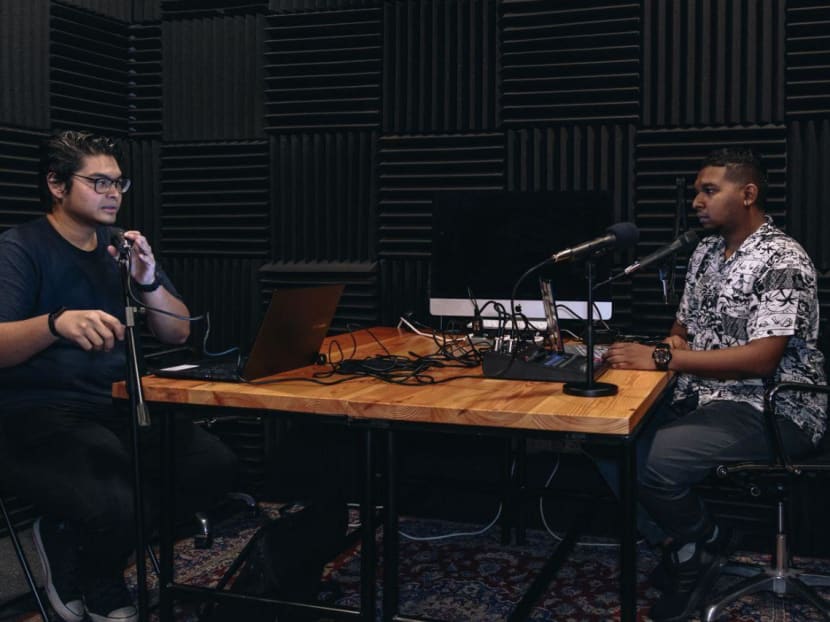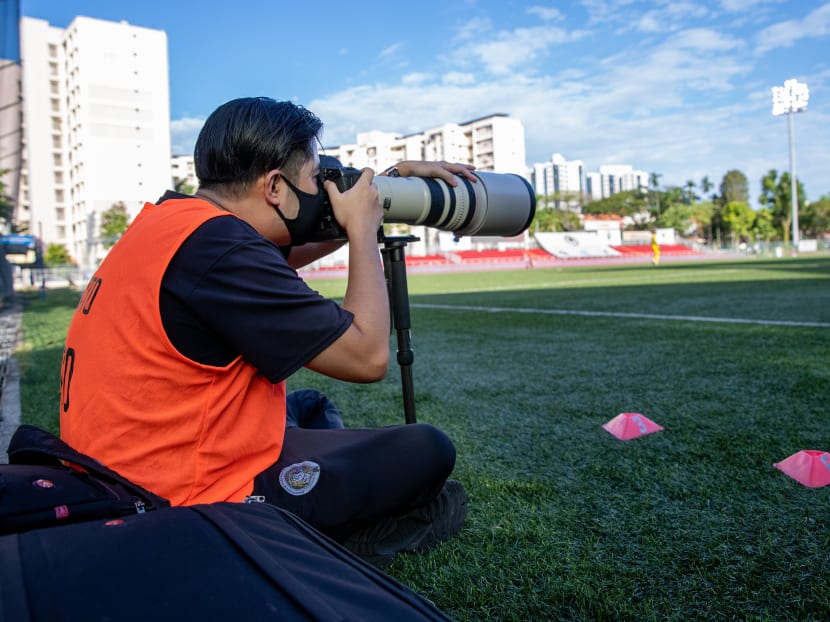'It's a duty': Fuelled by passion, fans create websites, podcasts, Instagram content about Singapore football
SINGAPORE — Mr Vikram Jayakumar, 25, finishes his 4,000-word interview piece with Geylang International’s retiring goalkeeper, Zainol Gulam. He uploads it to his website Soccer Kakis, then posts an Instagram blurb for his latest article.

Launched in 2020, The Final Whistle podcast is helmed by hosts Mohamed Khabir (left) and Deepanraj Ganesan (right).
Amid Covid-19, instead of travelling abroad for a module called Go-Far (Going Overseas for Advanced Reporting), 14 journalism students from Nanyang Technological University focused on Singapore's national football project to qualify for the 2034 World Cup. The Wee Kim Wee School of Communication and Information (WKWSCI) undergraduates reported on what it will take to raise excitement and the standard of the sport here. This article is the second of three that TODAY is running. Read the first one here.
SINGAPORE — Mr Vikram Jayakumar, 25, finishes his 4,000-word interview piece with Geylang International’s retiring goalkeeper, Zainol Gulam. He uploads it to his website Soccer Kakis, then posts an Instagram blurb for his latest article.
This is just a small part of what he does as a fan media creator.
With his partner Jack Transou, 25, and two other writers, Mr Vikram provides articles, podcast episodes and bites of Instagram content on his website. This year, it garnered 29,000 views from places such as Singapore, Indonesia, Australia, Cambodia and the United States.
More football fans in Singapore have started independent media platforms to focus on the local league. Through social media, blogs and podcasts, they have more freedom to report on what they want.
“We are sharing stories that mainstream media does not think is necessary because it’s not newsworthy or profitable enough,” Mr Vikram said.
To him, fan media is meant for a niche community eager for information.
Mr Vikram thinks there is still too little written about Singapore football on accessible sites such as Wikipedia, compared to information about English clubs on the internet and social media.
With a degree in history, he has also spent a fair amount of time studying local newspapers from the early 2000s and noted that the spotlight on local football has been progressively dimming in the mainstream media.
WANING COVERAGE
In the heyday of Singapore football, stories were splashed across newspapers.
From comprehensive match reports to exclusive interviews with players and coaches, readers followed all the latest happenings.
The New Paper, in particular, would have up to 20 pages dedicated to the sport, with local football taking up a sizeable portion, said veteran sports journalist Godfrey Robert, 74.
He recalled the height of football interest in the 1970s and 1980s, when Singapore took part in the Malaysia Cup.
“We covered everything from the vibrant atmosphere to pitch invasions, and even the squabbles between referees,” said Mr Robert, who was sports editor at The Straits Times from 1982 to 1999.
“The desk also used to get calls all the time with news leads about local football,” he added.
Mainstream media played a vital role in steering conversations on football, rallying fan support with stories of the national team’s successes and riling them up with reports of losses and bad gameplay.
Quah Kim Song, 69, a former national striker who played in the Malaysia Cup, said: “In the past, sports journalists could sway the public’s sentiment with a stroke of their pen.”
Mr Robert said: “You need heroes. You need champions that people want to read about.”
FILLING THE VOID
Instagram page Lions of Asia, which started out in April 2019, has already amassed over 4,000 followers and gained a reputation as a reliable source of timely updates on team lineups and live scores.
But it may come as a surprise to many that the face behind the account is a teenager residing in Cambodia, Sakada Sen.
Sen, 16, has been enraptured by Singapore’s league since the LionsXII days. To him, the local league has the potential to become an “Asean powerhouse”.
Singaporean media outlets, he said, have far better means to report on quality football content compared to the Cambodian media.
However, he feels the media here is not doing enough to market local leagues to fans. And so, fan media swoops in to save the day.
As a fan himself, Sen understands what fans want to see and what they care about. Apart from news updates and announcements, he also makes memes to engage fans throughout the season. “Someone needs to step up and do it,” he said. “We need to raise the bar of Singapore’s football news,” he said.

LABOUR OF LOVE
While their drive to shine light on the local league is strong, the harsh reality for these creators is that many of them must bleed time, effort and money to keep their ventures afloat.
For instance, on top of creating content for Soccer Kakis, Mr Vikram works as a project manager at a non-governmental organisation and is also studying for his master’s degree.
“It is a glorified passion project,” he said. “Unless there is major interest in the local scene, it will be hard to make this a full-time job.”
Other veterans in the fan media landscape agree.
Mr Jun Tan, who started his website Junpiter Futbol in 2011, wakes up at 5am every day just to edit photos and write articles for his blog. The 40-year-old sometimes even has to pay for photographers and writers out of his own pocket, as his website does not generate any income.
“I have to juggle my day job as an events manager and spend time with my family in the evening, so the only time I have to run Junpiter is in the morning,” he said.
Besides time constraints, he also finds it difficult to obtain media passes to cover local matches.
“We’re not as recognised as mainstream media outlets, so we don’t always get to attend the games,” said Mr Tan, adding that Covid-19 restrictions have also reduced the number of media personnel allowed at matches.
Still, these creators believe their work is worthwhile.
Mr Ko Po Hui, 46, has been covering local football on his blog, Bolasepako, since 1996. “It’s a duty to spread the gospel of local football,” he said.
His favourite memory from the past 25 years is meeting local football legend Fandi Ahmad.
“I grew up watching him play for Singapore, so I was really starstruck when I finally got to meet him,” said Mr Ko.
Mr Leo Shengwei, 39, who founded the fan website Playmaker in 2011, said he feels gratified when players recognise him and thank him for his photos.
One of his favourite footballers, Tampines Rovers player Baihakki Khaizan, gave Mr Leo his jersey after the match when he was covering the LionsXII’s victory in the 2013 Malaysian Super League.
“It really makes up for all the effort I put into this,” he said.

BIG BUCKS
While these fan media platforms range between 500 and 27,000 in followers, they all struggle to monetise their content. But one group thinks they have succeeded in turning their passion project into a viable business.
Launched in 2020, The Final Whistle (TFW) podcast is helmed by hosts Deepanraj Ganesan, 26, and Mohamed Khabir, 31, and sound engineered by Mr Nazhan Achmad, 36.
The podcast focuses on discussing football in a raw and candid manner. It has over 50 episodes featuring current players, legends and coaches, with some episodes attracting over 2,000 unique listeners.
“Nostalgia is a big part of Singapore football. People like to hear from past heroes because it gives them a good feeling,” Mr Deepanraj said.
A freelance sports journalist and football aficionado, he had always wanted to start a podcast, especially after following The Guardian’s Football Weekly. TFW was born when he was approached by Mr Khabir and Mr Nazhan, who are both self-employed, to help produce a similar platform.
Like many fan media creators, the team behind TFW fork out their own money for studio bookings.
Although their main goal was never to earn money, the trio were recently offered a five-figure sum by Singtel’s English Premier League arm, LIVENow, to monetise their new show, TFW Premier League Weekly.
“With the extra money, we can hire a cameraman and start uploading local football content onto YouTube,” said Mr Deepanraj. “From there, we can hopefully start to monetise content on local football.”






